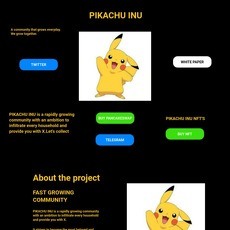If your website is on the scam list and you think that you are not a scammer, contact us. After you provide us with all the proof that you are in Crypto World with good intentions, we will delist you. Usually, you get in this category because you are hiding your team, you have a bad reputation(you are tricking, deceiving, scamming people), and you haven't got a written project whitepaper or is a shitty one....
Their Official site text:
This whitepaper provides an architectural overview of the Ozone chain platform, which is a quantum secure and quantum resistant blockchain. Ozone chain incorporates cutting-edge advances in post-quantum cryptography (PQC) and quantum random number generation (QRNG) and to provide a unique solution in the blockchain space to deliver the highest level of security to the digital assets residing therein.
Disclosure: The information described in this paper is preliminary and subject to change at any time. Furthermore, this paper may contain forward-looking statements.
Introduction
The progress in developing quantum computers has threatened the commonly used symmetric and asymmetric key cryptographic systems, which is used by all the existing blockchains. Quantum computers are capable of breaking many forms of traditional cryptography because of their inherent quantum properties such as superposition and entanglement, coupled with quantum algorithms, which take advantage of those properties and accelerate the cryptanalytic computation[1].
This has motivated Ozone for the study and development of quantum security solutions like post-quantum cryptography and quantum random numbers applied to blockchain. Ozone chain is resistant against quantum as well as classical attacks and can be deployed in the existing network infrastructure.
Ozone plans to focus on improving the blockchain security in two key areas:
I. Post Quantum Cryptography (PQC):
Ozone chain's network layer involves the usage of quantum communication and quantum computation to perform various cryptographic tasks and secure the transmission of data. Ozone chain uses a variant of Post Quantum Cryptography called Lattice based cryptography. Lattice-based cryptography has been proven to be highly resistant to subexponential as well as quantum threats. Ozone nodes communicate with each other through a specially created bi-directional quantum tunnel that deploys lattice based cryptography to encrypt and decrypt data. This encrypted communication channel or the data intercepted therefrom is resistant to attacks even by a future quantum computer.
II. Quantum Random Numbers (QRN):
Current blockchain solutions use pseudo-random numbers (PRN) to perform cryptographic functions like hashing, encryption and digital signatures. These use mathematical algorithms to create numbers that appear random but are deterministic if all inputs and processes are known. Ozone's relies on the quantum state of matter for generation of random numbers which are non-deterministic[2]. The QRNs are used in Ozone chain's cryptographic protocols to generate seeds, initial random values, nonces (salts), blinding values and padding bytes.
Ozone chain's cryptographic layer and network layer are built using the above mentioned quantum security technologies. Thus, Ozone chain provides unprecedented security to the digital assets like coins, tokens and NFTs residing therein.
The Arrival of Quantum Computing
If you think you understand quantum mechanics, you don’t understand quantum mechanics.
➤ Richard P. Feynman.
Quantum computing is a rapidly-progressing technology that exploits the laws of quantum mechanics to solve problems that are considered too hard and complicated for classical computers. Quantum mechanics deals with nature at the smallest scales, exploring interactions between atoms and subatomic particles. Quantum computing is a type of computation that harnesses the collective properties of quantum states, such as superposition, interference, and entanglement, to perform calculations.
Quantum computers are capable of solving certain computational problems, such as integer factorization (which underlies RSA encryption), substantially faster than classical computers.
Bits to Qubits
Classical Computers
Classical computers use binary digits or bits (0s or 1s) to store, transfer, and manipulate data. A bit can possibly be only one of two states: a one or a zero. It is either on or off.
Physically, a bit is represented in terms of a voltage inside a transistor, a magnetic domain on a hard disk, or light in an optical fiber. The binary nature of a bit occurs because the manipulated particles are being manipulated as whole particles.
Quantum computers
in quantum computing the smallest unit of measurement is called a quantum bit or a qubit. Quantum computers allow manipulation of subatomic particles in a non binary way, using their quantum properties.
Quantum superposition allows the particle to occupy both zero and one at the same time. The principle of superposition found in qubits is demonstrated using a Bloch sphere. Qubits contain probabilities for delivering the value of 1 or 0. Upon observation using a powerful electron microscope, the qubit will stick to representing one of those values.
Physically, a qubit can take the form of a a photon or a subatomic particle like a single electron, or neutrino, a superconducting circuit like Josephson junction, or Nuclear magnetic resonance on molecules in solution. Efforts towards building a physical quantum computer focus on technologies such as transmons, ion traps and topological quantum computers, which aim to create high-quality qubits.
A chronology of Quantum Computing
Throughout the 19th century, scientists’ understanding of the atomic model was beginning to shift towards the concept of subatomic particles like neutrons, electrons, and protons and their corresponding characteristics.
1905 - Albert Einstein discovers the photoelectric effect. When light is incident on certain materials, it cause to release electrons from the material. Light itself consists of individual quantum particles or photons. This is in contrast to classical electromagnetism, which predicts that continuous light waves transfer energy to electrons.
1925 - A conceptually autonomous and logically consistent formulation of quantum mechanics called matrix mechanics formulated by Werner Heisenberg, Max Born, and Pascual Jordan. Physical properties of particles are interpreted as matrices that evolve in time.
1935 - Albert Einstein, Boris Podolsky, and Nathan Rosen (EPR) publish a paper highlighting the paradoxical nature of quantum superpositions and arguing that the description of physical reality provided by quantum mechanics is incomplete.
1935 - Erwin Schrödinger, discussing quantum superposition with Albert Einstein and critiquing the Copenhagen interpretation of quantum mechanics, develops a thought experiment in which a cat (known as Schrödinger’s cat) is simultaneously dead and alive; Schrödinger also coins the term “quantum entanglement”.
1985 - David Deutsch of the University of Oxford formulates a description for a quantum Turing machine. The principle states that a universal computing device can simulate every physical process.
1992 - The Deutsch–Jozsa algorithm is one of the first deterministic quantum algorithm that is exponentially faster than any possible deterministic classical algorithm.
1994 - Peter Shor of Bell Laboratories develops for factoring integers. It has the potential to break RSA-encrypted communications, a commonly-used method for securing data transmissions.
1994 - The National Institute of Standards and Technology organizes the first US government-sponsored conference on quantum computing.
1999 - Yasunobu Nakamura of the University of Tokyo and Jaw-Shen Tsai of Tokyo University of Science demonstrate that a superconducting circuit can be used as a qubit.
2004 - First five-photon entanglement demonstrated by Jian-Wei Pan's group at the University of Science and Technology in China.
2011 - The first commercially available quantum computer is offered by D-Wave Systems.
2017 - Chinese researchers use quantum entanglement to accomplish the first quantum teleportation of independent single-photon qubits from a ground observatory to a low Earth orbit satellite with a distance of up to 1400 km.
2018 - The National Quantum Initiative Act is signed into law by the US President, establishing the goals and priorities for a 10-year plan to accelerate the development of quantum information science and technology applications in the United States.
2019 - Google's quantum processor named Sycamore having 53 qubits reaches quantum supremacy by performing a series of operations in 200 seconds that would take a supercomputer about 10,000 years to complete.
Current status of Quantum Computing
Recent years saw a rising interest in quantum computing, fueled by several breakthroughs on the technology side and a significant increase in investments both from the private sector and governments.
Quantum machine learning, quantum simulation, quantum computation, quantum artificial intelligence, quantum linear algebra and quantum optimization and search are generating a lot of interest and now have industrial applications.
Quantum cryptography is being implemented in industries such as banking - Swiss private banks use it to protect sensitive data. Cloud providers have released a quantum machine learning toolkit on GitHub. IBM, Google, Alibaba, Microsoft, Amazon and others provide Quantum-as-a-Service (QaaS) cloud computing. Quantum Computing services are being provided at affordable rates, thus marking the mainstreaming of the technology for industries and consume
The Quantum Computing Threat to Blockchain
Blockchain and Quantum computing are two technologies awaiting a impactful collision. Cryptography is an essential component of both quantum computing and blockchain. It is predicted that the blockchain systems we have today will be outdated once quantum computers are commercially available on the market and become mainstream.
The data on the internet that is stored in servers and databases and is secured by current security mechanisms is vulnerable to cyber attacks. This threat becomes imminent as quantum computers are gaining traction. Information interchange on the internet as it exists in its current form uses the Rivest–Shamir–Adleman (RSA) algorithm and Elliptic-Curve Cryptography (ECC). These algorithms are used to encrypt and decrypt information transmitted over the internet. These algorithms fall inside a class of public-key cryptography or asymmetric cryptography generation of such key pairs are based on mathematical problems termed one-way functions.
The incapacity of a computer, or a supercomputer, or even a network of hundreds of supercomputers, to solve these math problems provides much of currently confided-on cryptography its defensive competence.
The capabilities of a Quantum computer
The problems and solutions created by cryptologists require far more effort than exponential time. Time scale solutions like polynomial, square root, quadratic, and factorial are all huge improvements on exponential time and are known as superexponential time scale solutions. Any computing agent that delivers these types of time advancements are a threat to algorithms which provide defense to underlying assets by banking on exponential time defenses. Any cryptanalytic attack that exceeds exponential time is a threat to cryptographic solutions that relies on exponential time protection. Qubits and quantum algorithms give superexponential problems and solutions.
The advent of quantum computing represents a epitomic shift in which digital technologies will encounter both challenges and opportunities. The capabilities of quantum computers are getting better at a very fast pace.
In 2012, a 4-qubit quantum computer was demonstrated to factor the number 143.
In 2014, a quantum computer could factor the number 56,153.
In 2019, Google and KTH Royal Institute of Technology published a paper titled "How to factor 2,048-bit RSA integers in 8 hours using 20 million qubits".
With each passing year, fewer and fewer qubits are needed for computation making error correction more efficient and quantum computers more practical.
The Security holes in Blockchain
Blockchain implements an open, distributed, cryptographically signed digital ledger that is secure against tamper and verifiable by the stakeholders. To prevent bulk rewriting of an entire sequence of blocks from some point in the past as well as attacks to deny service or grow the chain faster than legitimate sources can, a work requirement is added to make rewriting long chains prohibitive. For our purposes here, the relevant structure amounts to the following description: It is worth exploring the conjunction of blockchain technology and quantum computing in the following four areas.
Communication over the blockchain network
Inter-node communication relies on protocols such as HTTP. The security of the communication happens in HTTPS within the SSL/TLS protocol stack. TLS supports one-time key generation (which is not quantum safe) with AES for symmetric encryption and several non-quantum-safe algorithms for exchange and authentication, such as RSA, DH, ECDH, ECDSA, and DSA. This means that all internet communications, including transactions and messages sent between applications and nodes in a blockchain, will not be quantum safe when robust quantum computers become fully operational.
The use of Pseudo Random Numbers (PRN)
The blockchain consists of a sequence of blocks that are stored on and copied between publicly accessible servers. Each block consists of four fundamental elements:
a) the hash of the preceding block
b) the data content of the block (i.e. the ledger entries)
c) the nonce that is used to give a particular form to the hash
d) the hash of the block
All processes mentioned above require random numbers as inputs, which in the case of blockchains currently present, are obtained from pseudorandom number generator (PRNG). PRNG is not truly random, because it is completely determined by an initial value, called the PRNG's seed (which may include truly random values).
Digital signatures
Digital signatures are one of the most essential components of blockchain technology. Bitcoin and Ethereum use elliptic curve cryptography (ECC), particularly the ECDSA signature schemes on curve secp256k1. Others, such as EOSIO, use the NIST standard secp256r1 curve. NIST recommends that ECDSA and RSA signature schemes be replaced due to the impact of Shor’s algorithm on these schemes.
Hash functions
Hashing functions take an element from a set of infinitely many elements and gives an output from a finite set of 2256 elements in the case of the SHA-256 function that is used by most of the blockchain networks today. Thus, from a hash value stored in the blockchain, it is statistically impossible to obtain the element that resulted in that value. This property, known as irreversibility or pre-image resistance, guarantees the security of these operations even in the presence of quantum computers.
Additionally, hash functions are continually evolving for increased security. For example, if quantum computers evolve to the point of posing a threat to SHA-2, then SHA-3 is already standardized as an alternative that offers a higher level of security in NIST standard FIPS202.
Block mining
Blockchain networks that use proof-of-work as the consensus mechanism rely on finding nonces. Quantum computers will be able to find these nonces quadratically faster using Grover’s algorithm. However, this does not pose a major threat to the security of blockchain networks because the solution will be as easy as quadratically increasing the difficulty to compensate for the quantum advantage. In networks with consensus protocols that do not promote competition between nodes, such as the proof-of-authority used in the LACChain Blockchain, this threat will not exist.
Quantum Computing Threats to Blockchain
The computational data structure known as a blockchain provides an open, public, distributed ledger that has many interesting applications, including digital currencies. The security of this ledger depends on the difficulty of solving certain cryptographic problems which are undermined by the potential of quantum computation. Specifically, hashes as used in signing the blocks of the ledger can be compromised, as can any public/private key system which relies on the so called hidden subgroup problem.
Blockchains are at greater potential risk from quantum computing than other technologies because they are heavily dependent upon cryptography. The very premise of blockchain protocols is the computational infeasibility of inverting certain one-way hash functions, but these may be broken with quantum computers. At the same time, blockchains also stand to potentially benefit the most from the innovations developed in quantum cryptography.
Grover’s algorithm can dramatically speed up function inversion. This allows the generation of a modified pre-image from a given hash (a hash collision) allowing a signed data block to be modified. This voids guarantees of authenticity of the ledger entries undermining the entire blockchain. The speed-up due to Grover’s algorithm is a factor of the square root of the number of possible hashes, meaning that a hash subjected to quantum attack would only be as secure as one with half as many bits subjected to classical attack.
Grover’s algorithm is specifically a solution to the problem of finding a pre-image of a value of a function that is difficult to invert. If we are given a signature that is the hash value of some data













